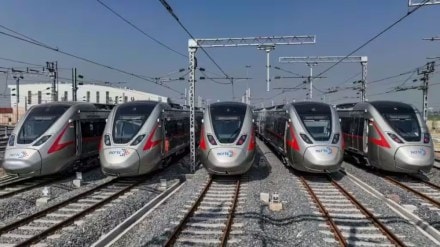The Delhi-Ghaziabad-Meerut Regional Rapid Transit System (RRTS), branded under the ambitious “Namo Bharat” initiative, is set to revolutionise commuter travel. This innovative transport network promises a departure from traditional metro and railway systems, catering specifically to passengers seeking efficient, high-speed transit over longer distances with minimal stops.
The RRTS project is a significant leap towards transforming regional connectivity in the National Capital Region (NCR).
How is RRTS different from Metro?
Unlike conventional metro systems designed for urban intra-city travel, the RRTS focuses on connecting regional nodes across the NCR. “RRTS is different from metro as it caters to passengers looking to travel relatively longer distance with fewer stops and at higher speed,” the NCRTC website highlights.
It is engineered to offer fewer stops and higher speeds, ensuring passengers can swiftly cover significant distances. With an operational speed of up to 160 km/hour and a design capability of 180 km/hour, the RRTS aims to cut travel times dramatically.
How is RRTS different from conventional Railways?
In contrast to Indian Railways, which primarily serves longer inter-city routes, the RRTS provides reliable, high-frequency, point-to-point travel at elevated speeds along dedicated pathways.
“RRTS is different from conventional Railway as it will provide reliable, high frequency, point to point regional travel at high speed along dedicated path way,” the NCRTC website highlights. This approach ensures commuters experience enhanced comfort and efficiency without the congestion typical of conventional rail services.
Delhi-Ghaziabad-Meerut RRTS Features and Benefits
- Speed: RRTS trains operate at an impressive 160 km/hour, making them three times faster than standard metro systems.
- Comfort: Passengers can enjoy a comfortable journey facilitated by modern amenities and spacious interiors.
- Frequency: The system is designed to operate at high frequencies, ensuring minimal waiting times for commuters.
- Connectivity: Inspired by successful international models like the RER in Paris and Regional-Express trains in Germany, the RRTS integrates seamlessly with existing transport networks, facilitating seamless regional connectivity.
Delhi-Ghaziabad-Meerut RRTS: Phase 1 Corridors and Central Hub
Under Phase 1 of the RRTS project, three key corridors are being developed:
- Delhi – Ghaziabad – Meerut Corridor
- Delhi – Gurugram – SNB – Alwar Corridor
- Delhi – Panipat Corridor
The Sarai Kale Khan station in Delhi serves as the central hub for all Phase 1 corridors, facilitating seamless transfers and ensuring efficient connectivity between Delhi and its neighboring states.
